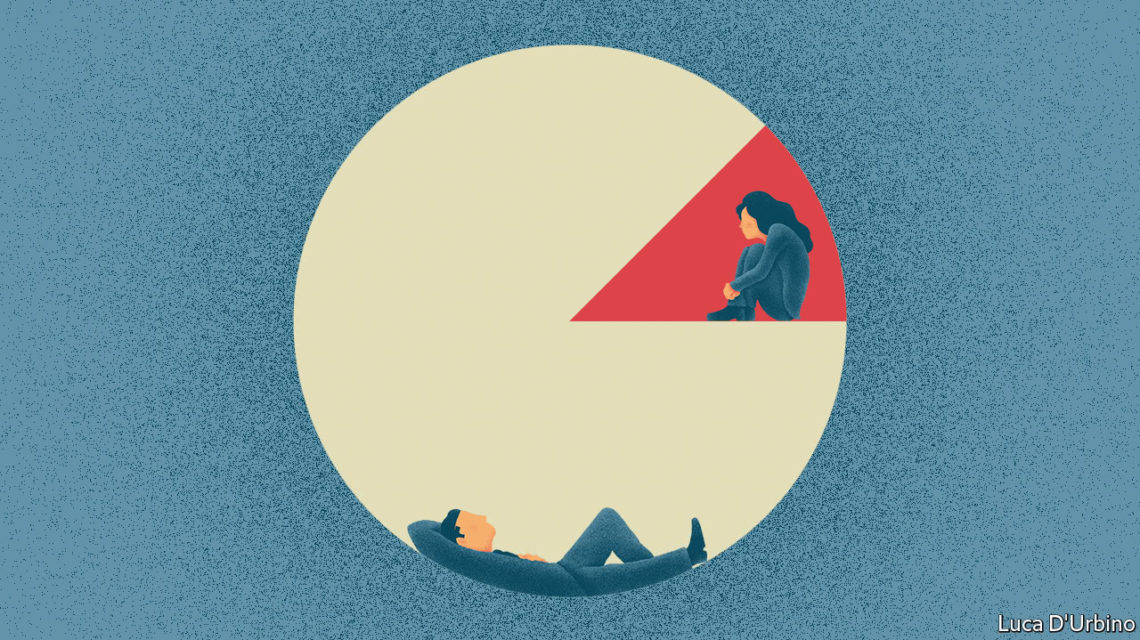The Economist, December 19, 2017 —
The profession’s problem with women could be a problem with economics itself
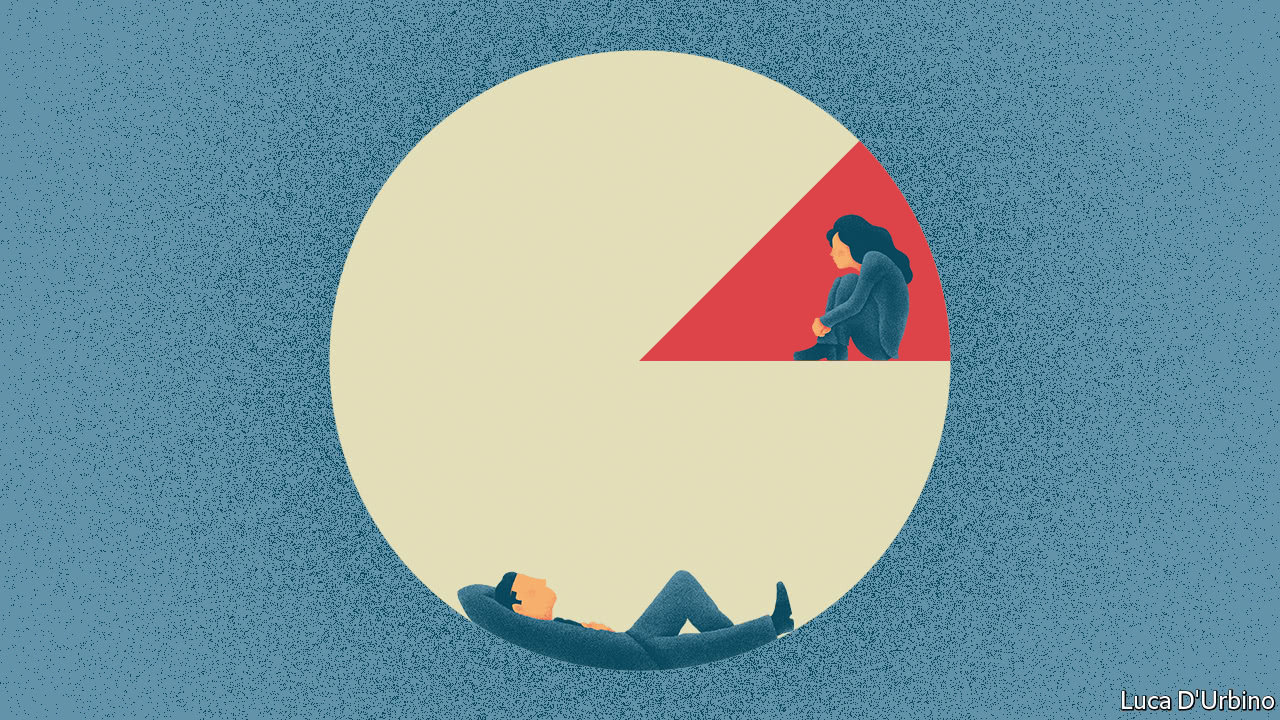
ECONOMISTS like to see themselves as generators of rational explanations. They scorn fuzzy thinking and beliefs that have no basis in fact; they attack problems with a ruthless logic. Happy as they are to turn this beady gaze on others, though, when it comes to looking at themselves they may be as befogged as anyone else.
Take the issue of female representation in their field. Academic economists are overwhelmingly male. According to information from university websites, about 20% of Europe’s senior economists are women. In America, 15% of full professors are women. At Harvard, arguably the most prestigious economics department in the world, the faculty pictures that beam down from the wall feature 43 senior members of the department. Only three are women. Two have tenure.
This does not mean there is necessarily a problem with economics per se. Though there are fewer women in economics than in the humanities, the other social sciences or the life and environmental sciences, there is similar under-representation in mathematics, engineering and physics.

Donna K. Ginther, PhD
Donna K. Ginther, Ph.D.But Donna Ginther, a professor of economics at the University of Kansas, has found telling evidence that women are not just scarcer in economics; they also face a thicker glass ceiling. Having started a job that has the prospect of tenure, women achieve that aim at a rate 12 percentage points below that of men. This is true even after adjusting (as much as possible) for differences in family circumstances and publication record. In American universities women who achieve tenure are promoted to full professor within seven years at a rate of 29% compared to 56% for men. Adjusting for other factors, Ms Ginther still finds a gap of 23 percentage points. In other social and natural sciences such differences are a thing of the past.
Unsurprisingly, given the above, women in economics are unhappier both than the men they work with and than the women who work in other disciplines, including those with similar gender disparities. In maths, computer science, engineering and the physical sciences, Ms Ginther found no discernible difference between the satisfaction reported by men and women with tenure or on the tenure track. In economics the gap is quite big. And it is growing larger (see chart).
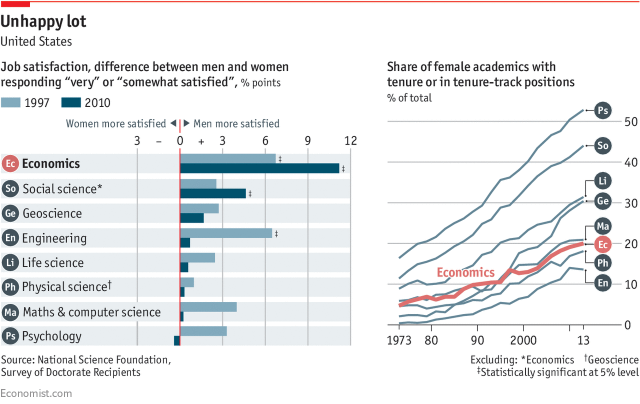
Ms Ginther’s work is part of a mounting case that economics has an insidious bias against women. If this is so it is bad both for women in the profession and for women who might have entered the profession but did not. And it is bad for men in the profession, who are stuck with less impressive colleagues than they might otherwise have and less diverse workplaces.
There is every chance that this lack of diversity constrains or distorts the field’s intellectual development. Women within economics have different opinions from men: in 2013 a survey of American economists found that men in the field were more sceptical of regulation and high minimum wages, and less likely to favour redistribution, than women were. If systemic gender bias skews the way the field looks at things, that has implications for the policymakers and others looking to academic economists for analysis, advice or indeed wisdom.
Who is rational, who is choosing?
The profession has not thought about these issues all that deeply. Beatrice Cherrier, a historian of economics at the University of Cergy-Pontoise, outside Paris, notes that when it does so, it tends to see the matter in terms either of inefficiency or choice.
In 1957 Gary Becker, an economist at the University of Chicago, suggested such an inefficiency might come from men not wanting female colleagues, and thus encouraging their managers to exclude productive workers. In a meritocratic, perfectly functioning market, competition would weed out such employers. Without tough competition, though, such prejudices would lead to good female researchers being shut out.
Given the problem’s persistence over the decades, this sort of argument leads to the conclusion that academic economics is not as open to the bracing winds of competition as those in the field have been schooled to believe. This may be why many prefer the alternative family of explanations which sees the poor representation of women as a rational choice. Women who might become economists will make the decision as to whether they should do so based on their abilities, their preferences and their constraints. If women are worse economists, or do not like the subject, then perhaps the choice which many of them make not to pursue the subject is an entirely rational one.
If relative ability or innate preferences are the dominant factor, then women’s under-representation is not a problem for economists to fix. If, on the other hand, women have a similar range of innate potential and inclination towards the subject as men, but are avoiding or leaving it because it treats them worse, then the burden is on economists to change. And that is the way that the evidence currently points.
Female economists start off in a minority. In America there are 2.9 men for every woman majoring in economics; in Britain, 2.6. In both countries women increasingly dominate the undergraduate population in general; in both the share choosing economics is falling. There may be some truth in the suggestion that women avoid it because they feel they lack the algebra-crunching ability it requires—but it seems there is probably not much. A study published in 2015 found that, in Britain, differences in maths qualifications explained only a sixth of the gender gap in applications. Research on why women at Harvard disproportionately give up economics after introductory courses also attributed only a small part of the effect to mathematical aptitude.
On average, it seems that undergraduate women who stick with economics are better at it than their male classmates. In Britain women in economics are more likely to get a 2:1 or a 1st than men are. This could be because quite a lot of men studying economics see it as a ticket to success in finance; they will stick with it despite a lack of aptitude in a way similarly able women do not.
A bias against bias
It is also possible that the way that economics talks about the world is less palatable to young women than to young men. A study published in 2006 found that women start introductory economics courses more sceptical about the subject than men, and the difference increases between the start and end of the course, despite no differences in their performance. Claudia Goldin, a professor of economics at Harvard, thinks the way that the subject is taught—with an emphasis on formalism, rather than human dynamics—could be part of the problem.
The women who graduate in economics go into PhD programmes at roughly the same rate as men; they tend to drop out of them at the same rate, too. But once they move on to seeking tenure, women are much more readily lost. This might mean that they are disproportionately pulled down other career paths they find more attractive than men do. It could also mean they are pushed out.
One common suggestion is that women do not like the famously combative style of economics seminars. Motherhood may also be an issue. American academics usually have the option to pause their tenure clock when they have a child. Heather Antecol of Claremont McKenna College and Kelly Bedard and Jenna Stearns of the University of California, Santa Barbara have found that this family-friendly policy disadvantages female economists. Women in the field taking advantage of the extra time mostly use it for child care; men often use it for focused research undistracted by students. The effect has been to lower the chances of a woman getting tenure in her first job by 22 percentage points.
This points to a more general issue about articles and publication. If women face a higher bar, one might expect them to be better than the men. But Ms Ginther finds that in the five years leading up to 2008, male economists published on average two more papers than female ones. A more recent study of the top 30 American universities found no statistical difference in the total publication count, but that men’s papers were published in more prestigious journals. If women are at best no more productive than men, a faculty-level gender disparity might be an efficient outcome, albeit one tilted by the disproportion in the pool of undergraduates. Actively seeking to change the ratio could damage the profession.
Ms Ginther is sceptical. People often behave according to biases they are unaware of; that could directly affect the promotion process. Take teaching evaluations. There is no evidence that women teach economics any worse than men; their students get the same grades in exams. But in 2017 a study found that student evaluations of female teachers in economics and business courses were systematically worse than those of men. Poor evaluations can affect tenure decisions. One speculative way of understanding this result, and perhaps the problem more broadly, would be to wonder whether economics attracts students particularly prone to sexism.
Or take publication. Erin Hengel of the University of Liverpool finds that papers by women submitted to Econometrica, a top journal, take six months longer to go through the review process than men’s do. She also finds that the abstracts of papers written by women are significantly improved (according to an objective measure of readability) between submission and final draft, and that as their careers progress, the women’s first drafts improve. Neither effect is seen in men (see chart). This suggests women are being held to higher standards, which may explain their lower publication count.
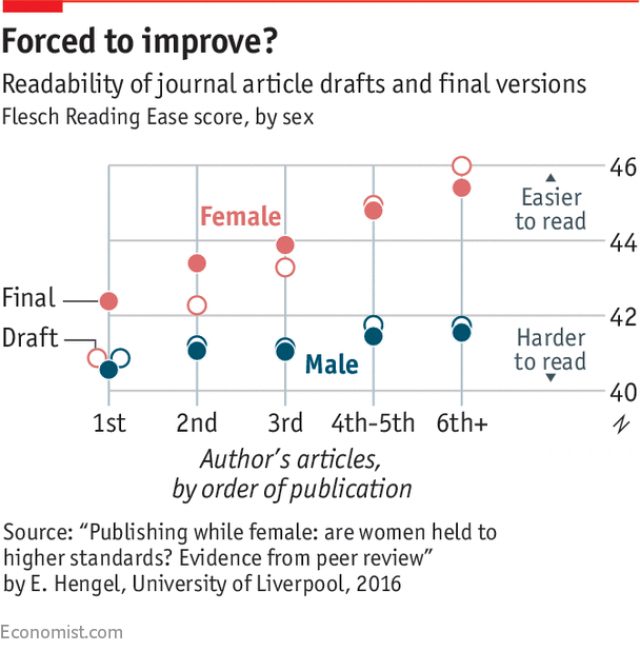
Heather Sarsons, a PhD candidate at Harvard, has investigated the effects of co-authorship. Looking at top American departments, she found that when researchers write papers on their own, women see their chances of promotion rise by roughly the same amount as men do. But when a man is a co-author on a paper he sees his chances of getting tenure rise by 8%, while for a woman the bump is a measly 2%. That adds up: Ms Sarsons finds women are 17 percentage points less likely to get tenure than men with similar publication records.

Heather Sarsons
It may be relevant that, in economics, authors are listed simply in alphabetical order; there is no information about who contributed what. In the absence of that information, implicit biases can run wild. Ms Sarsons notes that in sociology, where the lead author is listed first, there is no such co-authorship penalty. She also notes, anecdotally, that on occasions when she has seen the same research presented to different audiences by a male co-author and a female one, it has been her impression that the men’s presentations go down better.
Ms Sarsons found that colleagues responding to her paper were supportive, but careful to rule out alternative explanations. “Economists do tend to think about every possible channel. That’s good,” she says. She tested several such alternatives herself, and found them wanting: for example, women are not systematically co-authoring with higher-status men who might legitimately be imagined to be doing more of the work.
Some suggested that the people making decisions about promotion knew that men were choosing to co-author with less able women out of pity, or that women work less hard when there’s a man on the paper too. Neither Ms Sarsons’ research nor her experience lead her to entertain such notions. To some, this would seem like healthy scholarship. To others, this burden of proof when explaining gender disparities in their fields displays what Ms Ginther calls “a bias against bias”.
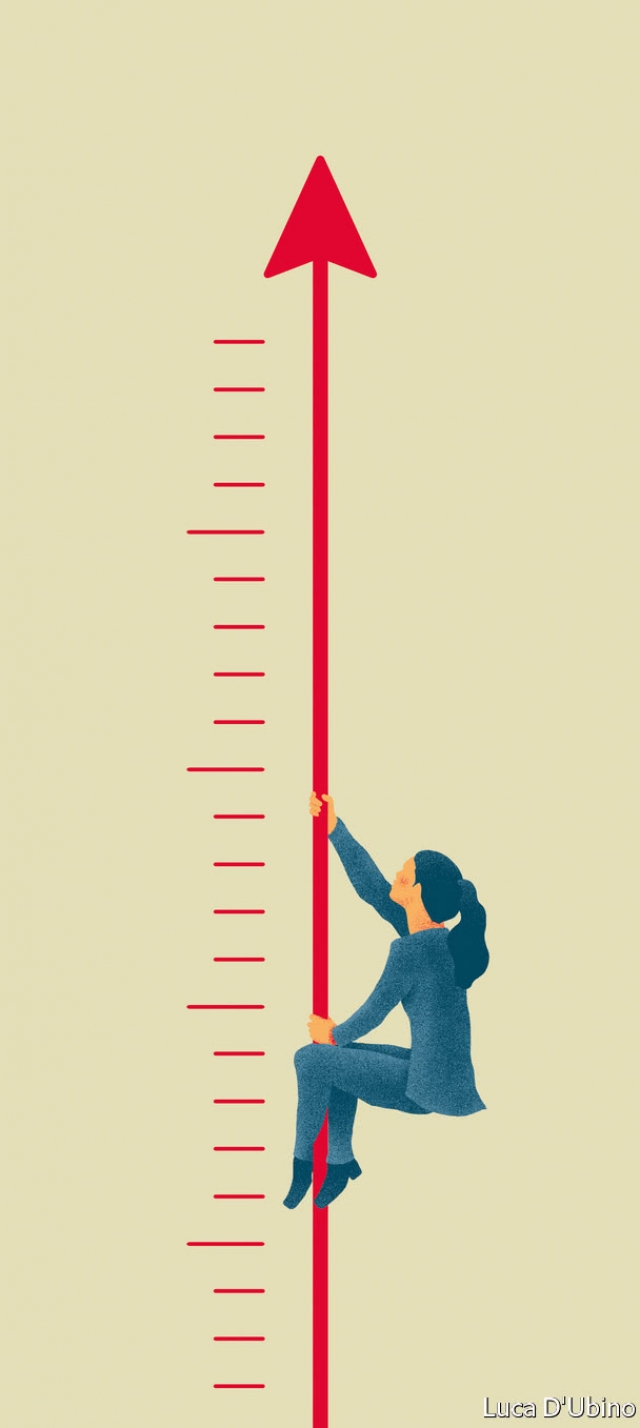
A-long-way-from-home economics
Economists are increasingly aware of this. David Laibson, the chair of Harvard’s economics faculty, has brought in Mahzarin Banaji, a leading researcher on implicit bias, to brief search and promotion committees. The representation of women is not the only issue here; economics departments are also unrepresentative in terms of faculty from various minorities. Mr Laibson is pushing his committees to lean less on intuition and opinion and more on engagement with the research itself when making decisions.
Because people research things based on their experiences, greater representation of women in the field would change it in a number of ways. For one thing, it would take gender more seriously. Men have not proved particularly interested in understanding gender disparity; almost all of the research on gender discrimination within economics is done by women.
There may be deep structural barriers to break through. Historians note that, over the course of the 20th century, economics was butched up. In 1920, 19% of doctorates listed in the American Economic Review were being written by women. By 1940 the number had fallen to 7%. This coincided with a redefinition of the field towards mathematics and the world of paid and thus predominantly male labour. Concerns such as social work and home economics, in which women tended to specialise, were sidelined.
Today, women in economics gravitate towards more people-oriented subdisciplines like health, education, development and labour.
Emmanuelle Auriol, who co-ordinates a network of female European economists, worries that this may disadvantage both those fields and the women who work in them. Journal editors and reviewers (who are mostly male) are less likely to be familiar with the subfields in which women are more represented; they may also think them less important.
It is possible the greater representation of women in these areas lowers their prestige. Whether that greater representation is a matter of choice—women may for various reasons find such work more interesting—or a result of women being pushed towards less prestigious topics is hard to say. If the latter, the dynamics will favour a vicious circle.
It is not just the topics women work on that matters; it is how they work on them. Becker won a Nobel Prize in part for his work on families and households—areas where female scholars tend to concentrate. His approach, though, was theoretical, while much of the work done by women has tended to be more applied and thus, Ms Cherrier points out, less prestigious. Up until the 1980s the data collection, microsimulations and randomised-control trials (RCTs) that women tended to do would struggle to reach the top journals.

Beatrice Cherrier, PhD
Since the 1980s, as applied microeconomics has become more prestigious and economists have changed the ways their theories have been tested, the women who have tended to do this sort of work have achieved better publication records, and risen in rank. But some, including Ms Cherrier, fear a backlash. For example, increasing criticism has been levelled at the RCTs in development economics disproportionately carried out by women. Rachel Glennerster, the director of the Abdul Latif Jameel Poverty Action Lab, a research outfit based at MIT that runs RCTs, worries that some of this criticism has a rather macho materiality, seeing health and education as minor relative to “bigger” issues like ports and roads. She repeatedly meets people who underestimate how hard the RCT approach is to run well. “As a society,” she wonders, “do we assume things are easier if there are more women doing them?”
Imbalances in power built deep into society are difficult to identify with an economist’s level of rigour. Gender cannot be switched on and off to see what would happen without it. But on the basis that economics does have a problem, various interventions might help. Approaches to family leave that don’t privilege men; scrutiny of the higher drop-out rate of female undergraduates; explicit description of each author’s contribution to co-authored papers, as is common in other disciplines; frank discussion of implicit biases. Some such interventions are easier than others. For example, studies show that having more women on the faculty is a powerful encouragement for women seeking postgraduate positions. But if the number of women on faculties could readily be raised, the problem would already have been solved.

